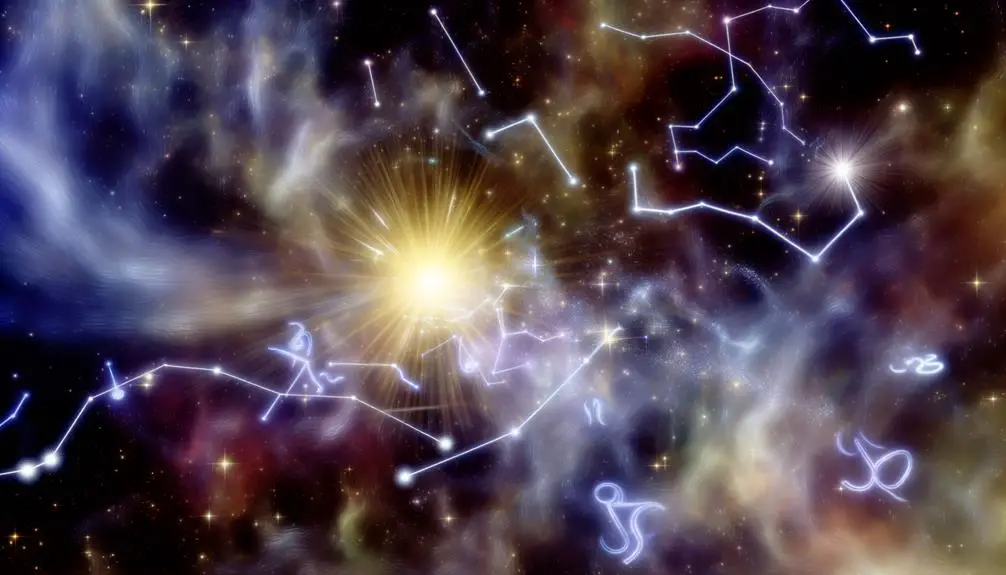What Is the Meaning of the Star Symbol Across Cultures?
The star symbol encompasses deep meanings across various domains. Historically, it aided in celestial navigation and storytelling.
Religiously, stars represent guidance and divine protection in Christianity, Judaism, and Islam. Astrologically, stars influence personality traits and life paths via zodiac constellations.
Culturally, stars signify spiritual aspirations and the souls of the deceased. In modern contexts, stars denote excellence in branding, celebrity status in entertainment, and functionality in digital communication.
Each interpretation reveals the enduring significance and multifaceted nature of the star symbol. To further understand its diverse implications, exploring the detailed contexts and historical backgrounds is essential.

Key Takeaways
- Stars symbolize divine guidance and spiritual aspirations across various religious traditions, including Christianity, Islam, and Judaism.
- Historically, stars were crucial for celestial navigation, timekeeping, and storytelling in cultures like ancient Mesopotamia and Greece.
- In astrology, stars are essential for creating horoscopic charts, linking zodiac signs to personality traits and forecasting events.
- Modern uses of stars include rating systems for quality, celebrity status in entertainment, and icons for favorites in digital communication.
- In cultural representations, stars often embody ancestral spirits, deities, and elements of the human microcosm, reflecting diverse cosmologies and beliefs.
Historical Significance

Throughout history, the star symbol has carried multifaceted significance across various cultures and civilizations, often embodying concepts of divinity, guidance, and cosmic order.
In ancient Mesopotamia, stars were integral to celestial navigation and timekeeping, symbolizing the gods' will.
The Greeks and Romans associated stars with mythological figures, embedding them in constellations that told stories of heroes and deities.
In the East, Chinese astronomers meticulously charted stars to predict imperial fortunes and natural events.
Indigenous cultures in the Americas utilized star patterns for agricultural cycles and spiritual rituals.
The star's role in maritime navigation, particularly during the Age of Exploration, further underscores its historical importance.
Therefore, the star symbol has been a pivotal element in humanity's quest to understand the cosmos.
Religious Symbolism

The star symbol's profound historical significance seamlessly extends into the domain of religious symbolism, where it often represents divine presence, spiritual enlightenment, and cosmic order across various faith traditions.
In Christianity, the Star of Bethlehem heralds the birth of Jesus, guiding the Magi to the nativity.
Judaism venerates the Star of David, symbolizing divine protection and unity.
Islamic tradition reveres the star and crescent as emblems of faith and guidance.
Hinduism and Buddhism also attribute celestial connotations to stars, associating them with deities and spiritual aspirations.
This multifaceted emblem serves as a bridge between the terrestrial and the divine, illustrating the shared human quest for meaning and transcendence within the contours of religious belief systems.
Astrological Interpretations

Astrological interpretations of the star symbol explore its role as a celestial guide, influencing human destiny and personality traits through the alignment of stars and planets.
Historically, astrologers have utilized star symbols to decode the cosmos, offering insightful predictions and understanding of life's complexities.
The star symbol in astrology encompasses:
- Zodiac Constellations: Each star sign within the zodiac is linked to specific personality traits and life paths.
- Planetary Influences: Stars indicate the positions of planets at the time of one's birth, shaping individual characteristics.
- Horoscopic Charts: Star symbols are vital in creating horoscopes that forecast personal and global events.
This approach provides a structured method to interpret celestial phenomena, aiding individuals in guiding their lives through astrological insights.
Cultural Representations
In diverse cultural contexts, the star symbol holds multifaceted meanings that transcend its astronomical origins, embodying ideals ranging from hope and guidance to divinity and protection.
In ancient Egypt, stars were seen as the souls of the deceased, guiding them to the afterlife.
The five-pointed star, or pentagram, in Western esoteric traditions, symbolizes the human microcosm and the balance of elements.
In Christianity, the Star of Bethlehem represents divine guidance and the birth of Jesus Christ.
Similarly, in Islam, the star within the crescent moon signifies divine light and guidance.
Indigenous cultures often view stars as ancestral spirits or deities, reflecting their cosmology and spiritual beliefs.
Therefore, the star symbol serves as a profound cultural connector.
Modern Uses

Today, the star symbol is ubiquitously employed in various modern contexts, ranging from branding and entertainment to digital communication and design.
In branding, stars are often used to convey excellence and high quality. For instance, a five-star rating system is widely recognized as a mark of superior performance.
In entertainment, stars symbolize celebrity status and talent, as seen on the Hollywood Walk of Fame.
In digital communication, stars serve as icons for favorites or bookmarks, enhancing user experience and engagement.
These diverse applications highlight the star's versatility and enduring significance in contemporary society.
Conclusion
In summation, the star symbol, much like a multifaceted gem, holds varied significance across historical, religious, astrological, and cultural contexts.
Its interpretations have evolved, reflecting society's changing beliefs and values.
Historically, stars guided travelers; religiously, they signify divine presence; astrologically, they influence human fate; culturally, they symbolize aspirations.
Modern uses continue to adapt these rich meanings, underscoring the star's enduring relevance and versatility.
The star remains a potent emblem, illuminating diverse aspects of human experience.




